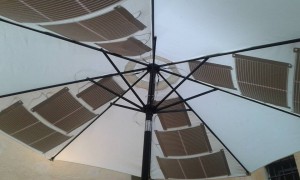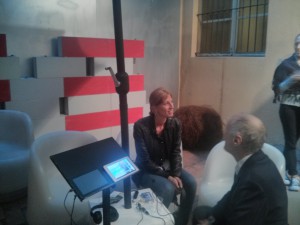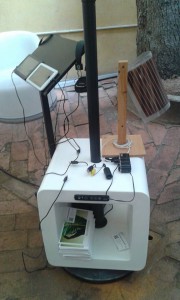In memory of the recently deceased Maria Rebecca Ballestra, we republish our article about “5 minutes free zone”, which was Artwork of the month in October 2015. Rebecca conceived the installation in cooperation with Lucia Palmero to point at the situation of emergency in Ventimiglia, the Italian frontier town at the border to France, where thousands of migrants were blocked for several weeks, due to the temporal suspension of the Schengen Agreement because of the G7 summit in the south of Germany. It is a good example of Rebecca’s engagement for humanity and sustainability and her efforts to cooperate with other artists. We sincerely regret to have lost her.
Artwork of the month / October 2015
 “5 minutes free zone”
“5 minutes free zone”Rebecca Ballestra & Lucia Palmero
Dimensions variable
Solar parasol, 2 iPhones, 1 external hard disk, 2 headphonesFilms:
- Statements: 52 sec, 1 min 18 sec
- Documentary: Alessandro Camillo for international.it, 30th June 2015, “Notti di frontiera Ventimiglia – Internazionale” (Night at the frontier in Ventimiglia – Intenational), 3 min 15 sec
- Documentary: InfoautVideo, 24th June 2015, “Reportage Ventimiglia: Voci e racconti dal presidio NoBorders” (Reportage Ventimiglia: Voices and accounts from the camp NoBorders), 9 min 26 sec
See the videos here.
There is a solar parasol which supplies the electricity for the iPhones as monitors and the hard disk, so that the visitors can follow the statements and two documentaries recorded in June 2015 in Ventimiglia, Italy, where refugees were blocked at the Italian-French border.
The statements are three small films turned by Lucia: a Sudanese and an Eritrean are speaking about their flight from Africa and their actual situation in Ventimiglia. Pasquale from Dolceaqua explains how he constructed a solar panel. In the video “Notte di frontiera Ventimiglia – Internazione” the visitor can follow the meditation and celebrations on the occasion of the international refugees day the 21st June 2015. The reportage “Voci e racconti dal presidio NoBorders” documents the situation in Ventimiglia in June 2015, with a statement of a Sudanese refugee and recordings of a demonstration for human rights and free movement of persons for all human beings.
The background: For several weeks there were thousands of migrants blocked in whole Italy, due to the temporal suspension of the Schengen Agreement because of the G7 summit in the south of Germany. Hundreds arrived in Ventimiglia to find their way to the north of Europe, but France closed its border for them as well. So the blocked people spent several days and nights on the bare red rocks of Balzi Rossi at the Mediterranean shore: they wanted to protest against this – for them not understandable – French decision, especially because most of them only wanted to pass trough France on their way to other northern countries.
During this period the small Italian frontier town was somehow in state of emergency: on one hand were the refugees, lacking almost everything; on the other the citizens, trying to provide them with their most essential needs. The atmosphere of solidarity in these days was impressive. Besides water, food, clothing and blankets, there was a need of electricity. A citizen recognised this necessity and brought, in addition to a parasol against the burning sun, a solar panel. This gave the stranded people the possibility to recharge their cell phones. This is an important communication tool, to stay in contact with people at home or at their destination or to friends as well on the journey, somewhere in between home and a safe country. In fact, for the refugees, on the road during many weeks, the telephone contact is often the only social contact to close people or people who could give a trusted advice: essential if you are somewhere all alone and not knowing where to go.
The reports of the refugees inspired Lucia and Rebecca to record the narratives. They wanted to give these people a space for their voice in an artwork, to break up the fact that refugees are often only known by numbers. But there are stories of unbelievable voyages, where people are forced to go from A to C and D to reach B. Often they are blocked somewhere in between because of the sea, a wall at the European external borders and recently even at the European inner borders, said to be open, but not for them. These flights leave the people often disorientated, since they are finding themselves often on unknown ways, not knowing exactly where they are, neither where they will finally arrive: like in a labyrinth.
Due to this recognition Lucia and Rebecca decided to integrate a solar parasol (provided by Ombrellone solare) and the recordings and two documentaries made by local TV stations to Rebecca’s current exhibition “The truth of the labyrinth” at the Spazio Testoni, Bologna, Italy. From 30th September 31th October 2015 the installation could be seen there.
The irony of the events wanted, that just in the morning before the opening the Italian police dissolved the self organized protest camp of refugees in front of the Italian-French border. 30 migrants and 20 activists fled back to the red rocks of Balzi Rossi where they held out during the day. After hard negotiations they finally left the rocks in the afternoon to be transported into regular camps. With that ended for the time being the protest against the inhumane politics against the refugees. An hour later was the opening of the presentation of L ucia’s and Rebecca’s installation, so it got to be as well a testimony.
ucia’s and Rebecca’s installation, so it got to be as well a testimony.
“5 minutes free zone” motivated by the events of this summer in general and especially by the initiative of the solar panels, transforms documentary to an artwork with political claim.
“5 minutes free zone”
30 September – 31 October 2015
Galleria SPAZIO TESTONI
Via D’Azeglio 50
Bologna – Italy
www.spaziotestoni.it
Rebecca Ballestra
Born 1974 in Ventimiglia, Italy, († August 2020) Rebecca studied Fine Arts at the Accademia di Belle Arti (Academy of Fine Arts) in Florence. Her works are shown all over the world in personal and group exhibitions, galleries and art fairs, public and private collections. She was awarded with several international prizes in the United States, Korea, France, Monaco and Italy and held lectures and participated at symposiums in several European countries.
Since 2003 Rebecca went nearly every year to a residency in Europe, Asia, Africa and North and Latin America. Difficult to say if one of her great subjects “Journey” is the original of her travels or if her numerous voyages inspire the subject. In any case her works are dealing with “meditation of history, traditions and ancient customs in different countries” as “an instrument to escape Eurocentric perspective and to offer to the public a new point of active observation and criticism.” (Rebecca’s statement on her website)
The result of her many sojourns are often site and context specific projects, like the last undertaking: the two-year lasting “Journey into fragility” (www.journeyintofragility.com). Based on Massimo Morasso’s “Manifesto for the Earth and Man” Rebecca conceived twelve different projects in twelve different countries, which resulted in a permanent installation on the Isola della Certosa, Venice, inaugurated in May 2015.
In addition, the double personal show “Journey into Fragility and La Parole des Anges” with Julien Fiedler, was held at the Palazzo Molin, San Marco, Venice in 2015.
The exhibition, where the “5 minutes free zone” was integrated, was “The truth of the labyrinth”, a dialog in between Rebecca’s and Julien Fiedler’s works. It was presented in the Galleria SPAZIO TESTONI, also in 2015.
Lucia Palmero
Born 1980 in Bordighera, Italy, Lucia decided only one year ago to dedicate herself entirely to art. Before she frequented, since 1997, the Art Academy “Riviera dei Fiori G. Balbo” in Bordighera, Italy. In addition she took classes in figure drawing of the CCL in Roquebrune Cap Martin, France from 2006 to 2008. Her teachers were Enzo Consiglio, Pino Venditti, Clarindo Bassani and Ambrogio Porcheddu. She participated in several group exhibitions in the region of Ventimiglia-Bordighera. Her works are in private collections in Monte Carlo, Torino and Ventimiglia.
Since Lucia is strongly socially committed, she sees art as a possibility to bring attention to social issues. So it is not astonishing that she was actively involved to support the stranded refugees in Ventimiglia this summer. That might be a kind of political participation as an act of artistic creation in the sense of Josef Beuys’ extended concept of art.
However, Lucia is searching to express her concerns in experimental ways of art. Actually she is working on a project that will focus to the human rights.

